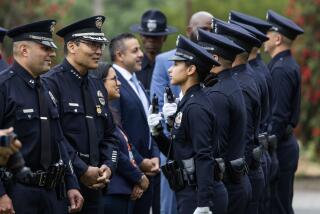Needs, Risks Determine Deployment
- Share via
The best method of deploying patrol resources has been debated since the inception of motorized patrols, and there seems to be no shortage of “experts” on the topic.
The article “Critics Say Two’s a Crowd in Patrol Cars--and a Waste” (Aug. 13) featured criticism of the practice of placing two deputies in rural beat cars during the evening hours. The implication was that this practice was outdated and appropriate only in high-crime areas.
The article quoted only three critics of our deployment strategy. They were a former deputy who left the department in 1969, a former detective from Detroit who refers to studies that have no bearing on our needs and geography, and a former assistant county attorney. None of these critics has the insight to make an informed decision regarding our operations or budget.
One critic said that one-person cars are statistically as safe as two-person cars. That is because officers take fewer risks when they work alone.
Another stated, “They have so much money, they can’t spend it all.” Although we normally have a budget surplus, it is not because we have too much money but because we allow for events such as earthquakes, floods, fires or riots. When extraordinary expenses don’t occur, we return the surplus to the general fund.
If I did have a “gold-plated budget,” our deputies would not be earning a below-average wage. We could serve more of the county’s 51,000 arrest warrants, repair a fire suppression helicopter and adequately staff our homicide and sex crime units.
This year as a result of budget cuts, we will have to leave 110 positions unfilled. The article failed to refer to the many supporters of our patrol deployment. Included in that group are the deputies who risk their lives daily, the citizens of the unincorporated areas we patrol (who remain underserved compared to their city neighbors) and the Ventura County Taxpayers Assn.
The article did not mention that the Los Angeles County Sheriff’s Department also uses two-person cars in all areas, including low-crime areas such as Agoura, Malibu and Valencia. Contra Costa County was noted as an example of a department that discarded two-person patrols. Your readers should know that they did so in the late 1970s to accommodate a shift change. They didn’t reduce the number of deputies; they just provided each deputy a vehicle. If I could afford the vehicles, I would do the same.
It is true that none of the local police departments routinely use two-officer cars. In the five cities where we provide contract law enforcement, we don’t either because the beats are relatively small and backup is close at hand. Unlike the cities, beats in the unincorporated area have radio dead spots and are geographically large, meaning that help can be more than 30 minutes away.
*
To reduce expenses, I direct that deputies being trained in patrol be assigned as the second person in an unincorporated area car whenever possible. Over the past year, trainees served in a two-person car 68% of the time at no additional cost. Every police department in the county uses two-person cars for field training.
Obviously, local police departments would like to have a greater share of Proposition 172 funds. The fact is, the distribution of funds from Proposition 172 was approved by the governor, state Legislature and voters of California to correct a property tax shift, which took most of the revenue from counties.
Although it is obvious that cities such as Santa Paula need a larger police budget, any contribution from us would result in reduced services for underserved areas such as El Rio, Santa Susana, Oak Park and Piru. We annually provide millions of dollars in regional services to cities through our crime suppression unit, air support, bomb squad, academy and crime laboratory.
Crime fighting is dynamic, and no deployment practice is universally preferable. This decision can only be made by reviewing each beat and its specific needs and risks. This review is just what my staff has been working on during the last several months to make sure the public and our deputies are provided the greatest level of protection.
The critics don’t want us to deploy the same number of deputies in more vehicles but to reduce the number of deputies on the street by half during evening hours. This is the same tired attack on the use of Proposition 172 funding. I do not believe that the residents of the unincorporated areas are willing to give up half of the deputies who protect them at night to fund non-public-safety agencies. As sheriff, I am responsible for the protection of the traditionally underserved unincorporated areas. As an elected official, I am also obligated to follow the expressed wishes of the voters, even when the critics think they know better.
More to Read
Sign up for Essential California
The most important California stories and recommendations in your inbox every morning.
You may occasionally receive promotional content from the Los Angeles Times.













